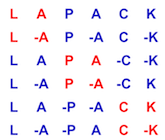 |
LAPACK 3.12.1
LAPACK: Linear Algebra PACKage
|
 |
LAPACK 3.12.1
LAPACK: Linear Algebra PACKage
|
| subroutine dlarrf | ( | integer | n, |
| double precision, dimension( * ) | d, | ||
| double precision, dimension( * ) | l, | ||
| double precision, dimension( * ) | ld, | ||
| integer | clstrt, | ||
| integer | clend, | ||
| double precision, dimension( * ) | w, | ||
| double precision, dimension( * ) | wgap, | ||
| double precision, dimension( * ) | werr, | ||
| double precision | spdiam, | ||
| double precision | clgapl, | ||
| double precision | clgapr, | ||
| double precision | pivmin, | ||
| double precision | sigma, | ||
| double precision, dimension( * ) | dplus, | ||
| double precision, dimension( * ) | lplus, | ||
| double precision, dimension( * ) | work, | ||
| integer | info ) |
DLARRF finds a new relatively robust representation such that at least one of the eigenvalues is relatively isolated.
Download DLARRF + dependencies [TGZ] [ZIP] [TXT]
!> !> Given the initial representation L D L^T and its cluster of close !> eigenvalues (in a relative measure), W( CLSTRT ), W( CLSTRT+1 ), ... !> W( CLEND ), DLARRF finds a new relatively robust representation !> L D L^T - SIGMA I = L(+) D(+) L(+)^T such that at least one of the !> eigenvalues of L(+) D(+) L(+)^T is relatively isolated. !>
| [in] | N | !> N is INTEGER !> The order of the matrix (subblock, if the matrix split). !> |
| [in] | D | !> D is DOUBLE PRECISION array, dimension (N) !> The N diagonal elements of the diagonal matrix D. !> |
| [in] | L | !> L is DOUBLE PRECISION array, dimension (N-1) !> The (N-1) subdiagonal elements of the unit bidiagonal !> matrix L. !> |
| [in] | LD | !> LD is DOUBLE PRECISION array, dimension (N-1) !> The (N-1) elements L(i)*D(i). !> |
| [in] | CLSTRT | !> CLSTRT is INTEGER !> The index of the first eigenvalue in the cluster. !> |
| [in] | CLEND | !> CLEND is INTEGER !> The index of the last eigenvalue in the cluster. !> |
| [in] | W | !> W is DOUBLE PRECISION array, dimension !> dimension is >= (CLEND-CLSTRT+1) !> The eigenvalue APPROXIMATIONS of L D L^T in ascending order. !> W( CLSTRT ) through W( CLEND ) form the cluster of relatively !> close eigenalues. !> |
| [in,out] | WGAP | !> WGAP is DOUBLE PRECISION array, dimension !> dimension is >= (CLEND-CLSTRT+1) !> The separation from the right neighbor eigenvalue in W. !> |
| [in] | WERR | !> WERR is DOUBLE PRECISION array, dimension !> dimension is >= (CLEND-CLSTRT+1) !> WERR contain the semiwidth of the uncertainty !> interval of the corresponding eigenvalue APPROXIMATION in W !> |
| [in] | SPDIAM | !> SPDIAM is DOUBLE PRECISION !> estimate of the spectral diameter obtained from the !> Gerschgorin intervals !> |
| [in] | CLGAPL | !> CLGAPL is DOUBLE PRECISION !> |
| [in] | CLGAPR | !> CLGAPR is DOUBLE PRECISION !> absolute gap on each end of the cluster. !> Set by the calling routine to protect against shifts too close !> to eigenvalues outside the cluster. !> |
| [in] | PIVMIN | !> PIVMIN is DOUBLE PRECISION !> The minimum pivot allowed in the Sturm sequence. !> |
| [out] | SIGMA | !> SIGMA is DOUBLE PRECISION !> The shift used to form L(+) D(+) L(+)^T. !> |
| [out] | DPLUS | !> DPLUS is DOUBLE PRECISION array, dimension (N) !> The N diagonal elements of the diagonal matrix D(+). !> |
| [out] | LPLUS | !> LPLUS is DOUBLE PRECISION array, dimension (N-1) !> The first (N-1) elements of LPLUS contain the subdiagonal !> elements of the unit bidiagonal matrix L(+). !> |
| [out] | WORK | !> WORK is DOUBLE PRECISION array, dimension (2*N) !> Workspace. !> |
| [out] | INFO | !> INFO is INTEGER !> Signals processing OK (=0) or failure (=1) !> |
Definition at line 187 of file dlarrf.f.